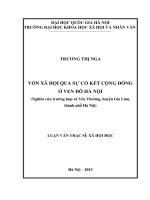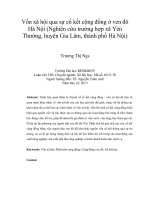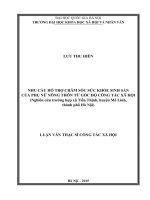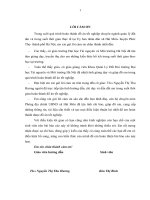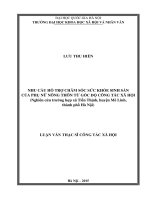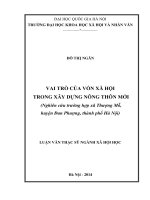Di sản hóa ở việt nam nghiên cứu trường hợp đền hát môn, huyện phúc thọ, thành phố hà nội tt tiếng anh
Bạn đang xem bản rút gọn của tài liệu. Xem và tải ngay bản đầy đủ của tài liệu tại đây (332.31 KB, 27 trang )
VIETNAM ACADEMY OF SOCIAL SCIENCES
GRADUATE ACADEMY OF SOCIAL SCIENCES
TRẦN THỊ LAN
TRAN THI LAN
THE HERITAGIZATION IN VIETNAM: THE CASE STUDY OF
HAT MON TEMPLE, PHUC THO DISTRICT, HANOI
Major: Cultural Studies
Code: 9 22 90 40
ABSTRACT OF DOCTORAL DISSERTATION
IN CULTURAL STUDIES
Hanoi, 2019
The work has been implemented at:
GRADUATE ACADEMY OF SOCIAL SCIENCES
VIETNAM ACADEMY OF SOCIAL SCIENCES
Supervisors:
1. Assoc. Prof. Dr. Luong Hong Quang
2. Ph.D. Hoang Cam
Cầm
Review 1: Assoc.Prof.Dr. Tran Duc Ngon
Review 2: Assoc.Prof.Dr. Dang Hoai Thu
Review 3: Assoc.Prof.Dr. Nguyen Thi Yen
The dissertation has been defended at the Academy-level Doctoral
Dissertation Assessment Council, held at Graduate Academy Vietnam Academy of Social Sciences
At: ………: …….. of (dd/mm/yyyy) ………….. 2019
Reference materials available at:
- National Library of Vietnam
- Library of Graduate Academy of Social Sciences.
LIST OF PUBLISHED WORKS OF THE AUTHOR
1. Tran Thi Lan (2018), “Participation of the state and
community in the heritagization of Hat Mon Temple (Hanoi)”,
Journal of Culture Research, Edition 24, P: 13-19.
2. Tran Thi Lan (2018), “Heritagization and the process of
heritagization in Vietnam since Đổi mới up to present”, Journal of
Culturology, Edition 5, P: 61-68.
3. Tran Thi Lan (2018), “Protection of cultural heritage in
modern society: A case of study of Hat Mon Temple in Hanoi”,
Magazine of Culture and Art, Edition 11 (66), P: 96-104.
INTRODUCTION
1. Rationale
Over the past few decades, cultural heritage has growing interest
from scientists, State administrative agencies and the community.
This proves that the natural heritages, relics and cultural practices are
increasingly demonstrating their roles, functions and significance in
the political, economic and social fields.
In Vietnam, since the renovation period, the restoration and
presevation of cultural heritages have clearly proved the policy of the
state. Many cultural heritages have been inventoried, selected and
documented on records at different levels. Heritagization is considered
a factor that changes the cultural practices of communities; strengthens
the relationship between the state and cultural bearers, the relations
between heritage and new cultural creations, and also cultural identity,
affirming cultural identity in modern time... On the other hand, during
the process of heritagization, the selection, restoration, heritage
ranking, relations between the community and the state... is a rather
complex issue that reflects multidimensional views, political
evolvements, and power interactions among groups in the society.
Hat Mon Temple (Phuc Tho District, Hanoi), an ancient relic in
the Red River Delta, is a place to glorify Hai Ba Trung- the two
women who are considered as symbol of the nation's unyielding and
indomitable fighting spirit. The worship of Hai Ba Trung for thousands
of years is not only of spiritual significance to the community, but also
of special importance in maintaining and raising the Vietnamese
people's consciousness on their ancestors and national - ethnic history.
Following the trend of heritagization, Hat Mon Temple was selected
by the state and ranked as a National Special Relic in 2013, the
1
Festivals of Hat Mon Temple was recognized as the National
Intangible Cultural Heritage in 2016. In fact, the discussions on the
heritagization and the process of establishing cultural heritage in
Vietnam in general and Hat Mon Temple in particular have posed
many urgent problems concerning theory and reality, which needs
more researches conducted. On that basis, I chose to do a research on:
The Heritagization in Vietnam: A Case Study in Hat Mon Temple,
Phuc Tho District, Hanoi, with the desire to share my views on the
problem and to constitute a rich contribution to the studies on cultural
heritage in Vietnam in modern time.
2. Objectives and tasks of study
2.1. Objectives
The thesis is to clarify the process of selecting and honoring Hat
Mon temple and its festivals as
cultural heritage; to explain the
political, social and economic evolvements of cultural heritagization in
Vietnam as well as the effects of heritagization on the protection and
promotion of cultural heritage. On the other hand, through the case
study in Hat Mon Temple, the thesis aims to explain theoretically the
heritagization trends viewed in reality of Vietnam, contributing to
enriching the studies on cultural heritage in Vietnam today.
2.2. Tasks of study
- To provide an overview of Hat Mon temple and its festivals;
the process of formation, development and the role of relics in
establishing national-ethnic identity ; and the significance to local
community in its history.
- To study theoretical issues concerning the trend of heritage in
Vietnam and in the world.
2
- To study systematically the process of selecting and honoring
Hat Mon Temple and its festival as cultural heritage; to point out the
transformation of the relic and its festivals after being honored; the
participation of the community and the state in the process of
heritagization of Hat Mon temple and its festivals.
- To discuss the issues that came out during the process of
heritagization in Vietnam in a transformation period.
3. Objects and Scope of study
3.1. Objects
The thesis aims to study Hat Mon Temple and its festivals, in
Phuc Tho District, Hanoi, and other the parties involved in the
process of honoring this cultural heritage.
3.2. Scope of study
- Scope of the content: The thesis focuses on studying the actual
heritagization of Hat Mon Temple and its festivals; The actions of
parties in the process of the heritagization.
- Scope of time: The thesis focuses on studying Hat Mon temple
and its festival from 1986 to 2013 and since the State has recognized
the Temple as a special national relic till now.
4. Methodology and study method.
Within this thesis, we approach cultural heritage in terms of
culture studies, power. Particularly, Political features of cultural
heritage are a focus of the research. In stead of seeing cultural heritage
as a calm entity using essentialism method, this study focuses on
working state of the heritage, especially, the political features of
heritage in a close relation with its social - political context.
3
The thesis uses the study methods of many different scientific
branches to study and fully explain the political features of cultural
heritage in the process of heritagization; they are:
- Observation;
- Deep interview;
- Synthesizing and analyzing documents.
5. New scientific findings of the dissertation
From a cultural perspective, the thesis aims to
clarify the
process of selecting and honoring relics and cultural practices as
cultural heritage with the participation of different branches. On the
other hand, the thesis analyzes the issues that come out after those
cultural heritages are honored. This helps to preserve and promote
cultural heritage values in Vietnam today.
6. Theoretical and practical meanings of the thesis
6.1. Theoretical meaning
The completed thesis will provide updated views, approaches
and the system of heritagization process in particular; hence will
help to protect and promote Vietnam's cultural heritage in general.
The analysis and summation of the thesis on the process of honoring
heritage such as the issue of marginalization, state-running, the
political features of heritage through a specific and objective case
study, the thesis will make substantial contributions in the field of
academic research on cultural heritage.
6.2. Practical meaning
From a specific case study, the thesis points out the practical
issues that the cultural heritage is facing before and after being
honored. At the same time, the results of the thesis provide a basis for
the orientation on protection and promotion of cultural heritage
4
values today. On the other hand, the results will provide an additional
reference for teaching and studying cultural heritage.
7. Outline of the thesis
In addition to the Introduction, Conclusion, References and
Appendix, the thesis consists of 4 chapters:
Chapter 1: Overview of research situation, theoretical basis and
research area.
Chapter 2: The honoring process of Hat Mon temple and its festivals.
Chapter 3: The Post-honoring process of Hat Mon temple and its
festivals.
Chapter 4: Heritagization of Hat Mon Temple and issues to
discuss.
Chapter 1
OVERVIEW ON STUDY SITUATION, THEORETICAL
BASIS AND STUDY AREA
1.1. Overview on study situation
1.1.1. Studies on heritagization
We divided studies into the following groups: Studies on
political and social evolvements of parties involved in the process of
heritagization; Studies on the impact of heritagization: positive
impacts, consequences for the protection and promotion of cultural
heritage values.
1.1.2. The studies on Hat Mon temple and its festivals
We divided the studies into the following groups: The studies on
the temple and its festivals viewed from historical perspective; The
studies on the temple and its festivals viewed from cultural
perspective and cultural management.
5
1.1.3. Reviews on the studies and tasks of the thesis.
Firstly, heritagization is an issue many researchers are interested
in, it is expressed through many articles and researches in both
theoretical and practical aspects. In general, the researches done in
the heritagization process have two sides. On the one hand, the
heritagization creates positive consequences in the protection and
promotion of heritage values after being honored; on the other hand,
heritagization leads to unexpected consequences such as “Staterunning”, “put-on-stage” and “tourism” of heritage, and the
“marginalization” for community-the owner of Cultural heritage.
Secondly, studies on Hat Mon temple and its festivals are viewed
from the perspective such as history, culture, cultural management. Many
of them mainly make a general introduction of the relics and its festivals.
From an overview of the studies, it shows that the recognizing and
honoring of heritage remains a a task for the researchers to do on Hat
Mon Temple. The actions of the parties, for the sake of politics,
reputation and identity in the process of selecting and recognizing a
specific cultural element as cultural heritage; the change of heritage after
having a certain title; The issue of state management and community
management which are applied in the managing of cultural heritage
before and after the heritage is honored, will be fully discussed in the
study on Hat Mon temple, hence to provide a comprehensive overview
on the process of heritagization in Vietnam. The studies of other scholars
will be an important source for our study.
1.2. Rationale
1.2.1. The concept
Cultural heritage: Cultural heritage is defined in Cutural
Heritage LawsV(2001) as “intangible and tangible cultural heritage;
6
spiritual and material product of historical, of cultural and scientific
value, handed down from generation to generation in the Socialist
Republic of Vietnam” [99, p. 8].
Heritagization: Combined with views of researchers, in this
thesis, heritagization is defined as the process of selecting elements of
a culture (buildings, monuments, relics, gardens, landscapes, objects,
practices, rituals, and traditions ...), and honoring it as a cultural
heritage in contemporary society, with various social - political
changes of participants (State, community, researchers, managers...).
Heritagization includes two successive stages: honoring stage and
post-honoring stage.
1.2.2. Some theoretical points
In this thesis, the reseacher adopted Oscar Salemink's
approaching method to consider the aspects related to the
heritagization of Hat Mon Temple.
Oscar Salemink discusses the political-social actions of the
parties involved in the heritagization process. Oscar argues that
heritagization “is not a one-way street. Many communities and
localities willingly participate in the process of seeking cultural
validation to achieve their own purposes” [168, p. 174].
On the other hand, Oscar believes that, through the process of
heritagization, a state has a deeper and deeper intervention in the
cultural practice of community, leading to the risk of deprivation of
cultural practice which was familiar with the community in the past.
The privilege is then given to tourism, economy, politics.
From Oscar Salemink's fundamental points, we decide to
consider the process of heritagization of Hat Mon Temple in reality.
The process will be considered on the following aspects: Firstly, the
7
political-social evolvements, the power relations in the process of
heritagization of Hat Mon Temple (participation, purpose of parties);
Secondly, the impact of the honoring process after Hat Mon Temple
and its festivals have been recognized as a cultural heritage.
1.3. Overview on the study area
1.3.1. Hat Mon land
Hat Mon commune is loctated in Phuc Tho district, 30km to the
northwest of Hanoi capital. Before The August Revolution in 1945, Hat
Mon belonged to Phù Long, Phuc Tho District, Son Tay province. It is a
village “the best village of the commune” with the rich traditional
cultural institutions of a village in the Northern Delta of Vietnam.
Since the renovation period, the appearance of Hat Mon has
changed rapidly. It no longer depends on agriculture, the people of Hat
Mon have actively changed their the economic structure, developed
handicraft industries, contributing to improving their material and
spiritual life.
1.3.2. General overview on the Hat Mon temple and its festivals
1.3.2.1. History of formation and development
Hat Mon Temple, Phuc Tho District, Hanoi is one of four ancient
temples in the Red River Delta that worship Hai Ba Trung. In its history,
Hat Mon temple has always been maintained and respected by the
people in the region. The kings in feudal dynasties have, for many times,
gave imperial edicts to the temple to commemorate the Two Women gods of the temple, as a way to ressure people and demonstrate the
strength of the unified nation and the power of the dynasty.
1.3.2.2. Landscape and architectural features of Hat Mon Temple
Hat Mon Temple was built to the north of the ancient village, it
looks in the south-west direction, and is situated on a high ground
8
with the disposition of “a curling Dragon and a lying Tiger”. The
temple consists of a complex of architectural structures with
different functions. Seen from the outside, there are such the
architectural structures as Quan Tien, Tam Ngu Temple, Four Pillar
Gate and a Ceremony House constructed on the lake which is on the
right of the path leading to the temple. Moreover, there are Dan
The, Nghi Mon, Ta Mac House, Huu Mac House. The main
structures of the temple includes Great Hall, Tien Te, Hau Cung,
stele house, Giau An mound, memorial house of Mrs. Nguyen Thi
Dinh, guest house and annex.
1.3.2.3. Hat Mon Temple’s Festivals
Hat Mon is a special temple with three major festivals that take
place annually, associated with the important events of Hai Ba
Trung: the festivals on March 6 to celebrate the day when the two
Women passed away; the Festival on September 4 to celebrate the
day the Two Women rose up in arms); the Festival on December 24
to celebrate the Two Women’s victory.
Sub-conclusion
Hat Mon is an outstanding cultural space of Doai region in
particular and the Northern Delta in general. The land has been
famous for its traditional cultural institutions. Hat Mon temple, which
is dedicated to Hai Ba Trung, stands out among many religious
structures in the village and has unique architectural features as well
as various festivals. Hat Mon Temple is recognized by the state as a
national cultural heritage in 1964, historical-cultural relic in 1991 and
special national relic in 2013. Hat Mon temple’s festivals are
recognized as intangible heritage in 2016.
9
The recognizing of Hat Mon Temple was conducted within the
trend of heritagization approached by researcher from different
aspects, one of the sesearchers is Oscar Salemink. According to
Oscar, that process represents social-political evolvements with the
participation of many different parties such as the state, the
community and scientists. Oscar argues that state’s intervention leads
to the risk of deprivation of cultural practices that were familiar with
the community in the past.
Oscar Salemink's approach has created a significant theoretical
foundation for our study on Hat Mon temple. It helps us to learn
about the actions of the parties, to view their benefits, politics,
reputation and identity in the process of selecting and recognizing a
specific cultural element as a cultural heritage; and to find out more
about the transformation of heritage after having the title as well as
the
issues
concerning
management
State
management
and
community
applied for cultural heritage before and after the
heritage is honored.
Chapter 2
THE HONORING PROCESS OF HAT MON TEMPLE
AND ITS FESTIVALS
2.1. The process of honoring Hat Mon Temple as a Special
National Relic
In the development history, in 1964, Hat Mon Temple was
ranked as a national cultural and historical relic. From late 2012 to
early 2013, Hat Mon Temple was selected as a part in the plan of
Hanoi City that prepares a profile for the the temple to be honored as
a Special National Relic. unlike before, this time, the selecting of
10
Hat Mon temple took place in a completely new economic, political
and cultural context.
At the beginning of 2013, implementing the plan of the city;
authorities, the officials of the Management Board of Relics and
Landmarks cooperated with the district authorities, the Department of
Culture and Information and the Department of Natural Resources
and Environment of Phuc Tho district to prepare a profile ranking
Hat Mon Temple. The background of the temple is one of the
important documents in heritage profile. In order to match with the
criteria which requests that historical and cultural relics be associated
with national heroes; the profile aims to emphasize life, career, the
Hai Ba Trung’s revolts and patriotically historical events which took
place in the lands where relics were established. In the record, Hat
Mon temple’s values in terms of
historical value, architectural,
artistic value, cultural and scientific values are also considered to be
choosen. The background of relic also mentions the plan to protect
and promote the cultural heritage values of Hat Mon Temple after
being honored.
Heritagization is defined as a process of selecting specific cultural
relics/practices, then honoring them cultural heritage; and in fact, the
honoring of Hat Mon Temple relic is also a process of selecting the
criteria and contents to match the title that relic aims to achieve.
2.2. The process of honoring the festival of Hat Mon temple
as a national intangible cultural heritage
In 2016, Hat Mon Temple’s festivals continue to be honored as
the national intangible cultural heritage. Similar to the process of
honoring a relic, the process of honoring festivals is the result of the
selecting contents and festivals to match the criteria of a National
11
Intangible Cultural Heritage which is defined in the legal documents
of the state.
Profile of Hat Mon temple’s festivals is oriented according to the
criteria of a traditional festival. The criteria are the standards in
producing scientific documents, and are issued by the Ministry of
Culture, Sports and Tourism in Circular No. 04/2010-BVHTT that
stipulate the standards in inventorying and making profile of
intangible cultural heritage. Therefore, the content of the profile is
considered whether it meets 4 criteria: "1. the identity of the
community and locality; 2. the cultural diversity and human
creativity which are handed down from generation to generation; 3.
Ability to recover and survive for a long time; 4. Advocated by the
community, voluntarily nominated and committed to protection
”(Article 10, Section 2, Circular No. 04/2010-BVHTT).
An important point in the background of Hat Mon temple which
is emphasized is the measures taken to protect intangible cultural
heritage in the future - this is one of the conditions that must be
included in the heritage profile. The background of the Hat Mon
festival has introduced a number of measures to protect and promote
the festivals today, especially emphasized the role of the community.
2.3. Role of State and community in the process of honoring
Hat Mon temple and its festivals.
Honoring cultural heritage is an important stage in the process of
heritagization, through which a relic or a cultural practice achieve titles
at different levels. During this process, there were participations from
many different parties, one of the parties that stand out is the state.
The preparation for the honoring profile of Hat Mon Temple (in
2013) and Hat Mon Temple’s Festivals (2016) were made by the
12
officials of the Management Board of Relics and Landmarks,
Department of Culture, Sports and Hanoi Tourism. Government
representatives and the Protection Board of Hat Mon Temple would
provide some support or information about the Temple. The entire
process of making the profile is implemented entirely by the officials
in charge.
It is not the people living in Hat Mon commune who are in
charge of selecting appropriate/inappropriate content of the honoring
profile but cultural managers, scientists, who are accustomed to
making similar profiles. They are qualified to choose what or what
factor to emphasize or honor.
In other words, the process of
honoring and ranking the cultural heritage is a "valuation and
evaluation process for experts and organizations/units, referring to
global cultural standards, not local cultural standards” [89, p. 494].
Sub-conclusion
With so many meanings and roles for the nation and the local
community, Hat Mon Temple has been selected by the State, and it
took a process for the honoring profile to be prepared and completed.
The process of building heritage profile is required to conform to the
criteria for special national relics (relic), national intangible cultural
heritage (festival) stipulated by the Cultural Heritage Law and
circulars, guidelines of the state. It is a process in which relics and
festivals are honored and given titles, but the honoring and ranking
have to be in compliance with the cultural standards certified by the
state. The process of building heritage profiles is also determined by
external factors, including cultural managers, experts, and scientists.
This has also become common in the management system of
Vietnamese cultural heritage nowadays.
13
Chapter 3
THE POST-HONORING PROCESS OF HAT MON
TEMPLE AND ITS FESTIVALS
3.1. The change of Hat Mon temple and its festivals after being
honored
The honor and recognition of cultural heritage have created an
important lever, leading to the change of relic and festivals in many
ways. Here, we only focus on discussing some major changes such as
restoring, building new constructions, and expanding relic planning;
reviving, creating more space for the festivals; promoting propaganda
and cultural heritage.
3.1.1. Restoration, reconstructions and expansion of
relic
planning
As for the restoration, reconstructions: Many constructions have
been renovated, reconstructed, changing the whole appearance of
heritage space. Some of the reconstructed structures are Memorial
House for Mrs. Nguyen Thi Dinh, Đàn thề, guest houses. Many new
artifacts are also supplemented in the relic space.
As for the plan to expand the relic: According to documentation;
previously, Hat Mon Temple was small. In 1993, the commune
authorities decided to grant a piece of land into the land of the
temple. The granted land is more than 13.000 square meters. After
being honored as a special national relic, Hat Mon Temple is planned
with an expanded area of 13ha. Today, the temple has been added
with such constructions as management area, discovery area, temple
of generals of Hai Ba Trung, temple of Mr. Thi Sach’s mother, and
traditional house for Vietnamese women.
14
3.1.2. To recover, create and expand the festival scale
After being honored, the scale of Hat Mon temple’s festival is
increasingly expanded in all of the three festivals. The scale of
festivals are now much greater; not village-scale but national scale,
attracting a lot of visitors from many regions. Many new rituals are
created and expanded such as the procession of Troi cakes, Trong
Quan singing is supplemented and carried out on the day of the
festival. In addition, many new activities
are also added in the
festival: they are commemoration meeting, Saluting the Colours,
National Anthem, Reward ceremony for people who make great
contributions to cultural preservation. Also in the meeting, a Central
company of classical drama was hired to perform the scene of "Hai
Ba Trung rose up in arms" bringing back the indomitable spirit of the
army led by the Two Women- Hai Ba Trung.
3.1.3. Promoting propaganda and cultural heritage
Many propaganda programs/activities are carried out to promote the
value and reputation of the heritage. Hat Mon temple heritage is
increasingly introduced through many different media which mainly
focus on promoting outstanding values of the special national relic,
and introducing festivals as national intangible cultural heritage
3.2. The role of the state and community in the post-honoring
process of Hat Mon temple and its festivals.
3.2.1. State’s participation
3.2.1.1. Management and restoration
After being honored as a special National Relic, the temple has been
administered by People's Committee of Phuc Tho District. Accordingly,
the People's Committee of Phuc Tho district assigns direct management
of Hat Mon temple to the People's Committee of Hat Mon commune.
15
Many projects of restoration and reconstruction are implemented by the
state. At the same time, when realizing that the temple’s donation is
growing, the government has kept control on these donations.
3.2.1.2. Organizing festival
From 2014, Hat Mon temple’s festivals were organized by the
district, guided by plans and documents. The theme of Hat Mon temple
festival is associated with the local political tasks: “Promoting the
spirit of independence and self-reliance of the Hai Ba Trung uprising,
the Party Committee and people of Phuc Tho district are determined to
make the hometown become rich and beautiful, civilized ”.(2018).
3.2.2. Community’s participation
3.2.2.1. Protection and restoration
Despite the fact that Hat Mon Temple is administered by a
management board , security guards working in the temple make an
enormous contribution to implementing all the work related to the
protection and preservation of relic, this reflects the active and positive
contribution of the community.
3.2.2.2. Organizing festivals
At Hat Mon temple festival, local authorities can intervene in the
community's heritage after honoring process, but on the other hand,
the community itself takes active actions to maintain and preserve
local traditional identities. Government intervention is mainly in the
festival , expanding the scale and influence of the festivals, but in
fact, the ceremony is still organized by the community. The
community still holds the post of a cultural bearer.
Sub-conclusion
After being ranked, Hat Mon temple and its festivals have
changed in many ways: the relic and its planning have been restored
16
and expanded. ; New elements as well as cutural practices have been
added to the festival. In fact, it is undeniable that honoring is an
important agent, leading to the change of the appearance of the relic
and its festivals.
Along with that, after the relic is honored, there is state
intervention in the management of local cultural heritage. The
government plays a role in advising and directing in the protection,
repairing, renovation, and organization of Hat Mon temple’s festivals
every year. However, the local community still plays an important
role as the organizer of the festival. As an organizer, the community
actively selected the participants and performers of
the rituals
according to the village tradition.
Chapter 4
HERITAGIZATION OF HAT MON TEMPLE AND
ISSUES TO DISCUSS
4.1. The political-social moves of honoring the heritage
4.1.1. State and process of heritagization
When discussing the heritagization from heritage honouring in
Vietnam, Oscar Salemink [88], [89], [90], Choi Horim [33], Nguyen
Thi Hien [47], etc emphasized that the cultural heritage is a
fascinating process for many different participants. They have a
move to actively participate in the heritage because each party finds
"certain interests" (may be different / may be conflicting) in
honoring. The reality of heritagizing Hat Mon proved this point. The
state, in the modern context, through honoring Hat Mon Temple to
build and strengthen nationalism, create a sense of an "imagined
community",
with
common
traditions
17
(national
tradition),
sovereignty, national identity, etc. And after all, heritage is a way for
the state to establish the legal ownership and management role with
cultural heritage. On the other hand, honoring heritage is a way to
serve different political purposes/tasks of each locality.
4.1.2. Community and process of heritage
Not only the state, but the heritagization also appeals to
stakeholders, including the community and many different groups such
as the village's people, the intellectuals or part of the new population
living in the local area. They actively participate in the process of
heritagization, but the purpose of each party is different.
The original people and intellectuals desire the relics and festivals
of the village to be honored, thereby, affirming their traditional cultural
values. Honoring heritage is also an opportunity to demonstrate and be
proud of the world outside the village. On the other hand, participation
in protection and promotion activities of cultural heritage also
facilitates individuals/groups to assert their position. The various sociopolitical moves in the process have clearly shown the social relations,
complex interactions in the context of the current transition.
4.2. The impacts of heritagization
4.2.1. Change in government and community awareness
The process of honouring and ranking relics and festivals in Hat
Mon temple has had certain impacts on the awareness of the
authorities and the community in many different ways, contributing
to the protection and promotion of the cultural heritage values.
4.2.2. The issue of marginalization after honoring
As stated in the rationale, when discussing the process of
heritagization, Oscar Salemink emphasized the issue of marginalization
as an unexpected consequence after the cultural heritage is honored.
18
From the fatcs of f Hat Mon Temple, the community has different
strategies, which is sometimes flexible, sometime resolutely negotiating
with the state to achieve its goals. They are not passive, not in the
position of "victim", are marginalized but are in the position of central,
active, proactive participants in the process.
In fact, for many other communities, honoring heritage has
opportunities to actively pursue their own cultural, economic and
political goals. Many places in the local community are
"marginalized" after the heritage is honored. That is the situation
when Giong festival heritage was honored by UNESCO, people are
even asked for money when participating in Giong festival, while in
the past it was an honor and pride [77]. No matter what level of
cultural heritage is honored, the role of the local community must
always be enhanced and respected, especially in traditional
ceremonies and cultural activities.
4.2.3. The issue of "stateization" after honoring
When discussing the heritagizatio, the issue of "stateization" of
the post- honoring the cultural heritage is shown in the researches in
Vietnam [74], [76], [77], [89], etc. This practice is quite common in
Vietnam today. It is the process of cultural transformation that
makes cultural heritage a "national asset", and on that basis will
lead to the "stateization" consequence of cultural heritage.
However, in the case of Hat Mon temple as practically the state's
participation in the restoration, protection, and organization of the
festival, one can see that the process of "stateization" and
"administration" is not the deep intervention of the state in the
cultural practices and beliefs of the community.
19
At present, the issue of "stateization" takes place in many cultural
relics and practices, such as the Hung Vuong historical relics complex,
Soc Temple, etc. The negotiation, compromise to be able to balance
and harmonize the role of the state and the community is necessary to
protect and promote the cultural heritage values after honoring.
Sub-conclusion
Studying the heritagization of Hat Mon temple shows that
heritagization is a process associated with complex socio-political
moves of parties. The state and the community all want a title of
heritage, but the purpose of each party is different. From this fact, it
helps to clarify Oscar Salemink's view of the heritagization: many
communities and localities are ready to participate in the process of
heritagization to serve their own purposes.
Heritagization has had impacts that change the awareness of
the community and the state, thereby leading to a change in the status
of relics and cultural practices. The reality cannot deny the role of the
current administration in managing relics and organizing festivals.
However, the local owners of relics and festivals also has different
strategies, demonstrating their own initiative and role of "selfdetermination". It is also the process that the Hat Mon village
community creates and affirms the local cultural identity in the
contemporary society.
CONCLUSIONS
1. In the globalization trend, heritagiation is considered an
activity not only to promote and honor but also to support and protect
the values of cultural creations of ethnic groups or a specific
community. This activity is very much concerned by the countries
20
through which the state can be more closely connected with the local
community in social management, strengthening its political position
as well as preserving the national cultural identity.
In Vietnam, the process of heritagization has been implemented
since the 1960s of the twentieth century but expanded after the
country implemented the renovation. In particular, heritage has
become one of the important tasks in the national cultural
development orientation when Vietnam promulgated the Cultural
Heritage Law in 2001.
2. Hat Mon Temple in Hanoi City is a temple with an important
role in history, in the political and cultural life of the community,
because here, the worshiped character is Hai Ba Trung. - women who
have been historically noted to have fought against the invaders and
defended national independence.
It is no coincidence that the interest in Hat Mon and Hai Ba
Trung temples has increased especially since Vietnam international
intergrated, facing challenges and many problems in preserving
national identity. In 2013, Hat Mon Temple was recognized by the
State as a special National Monument. Next, in 2016, Hat Mon
temple festival was registered by the state as a national intangible
cultural heritage.
3. Through the Hat Mon temple and festival, it can be seen that
heritagization is an indispensable process with the participation of
many different parties, with different strategies, creating a colourful
picture in Vietnam after innovation. On the state side, it is the
propaganda to promote and symbolize Hat Mon festival and
monument, the intervention in the organization stages, creating new
discourse ... The State uses cultural heritage to legalize, strengthen
21
and affirm its political power. The State needs "title", needs
"righteousness" to serve different purposes.
On the community side, it is the proactive approach, efforts to
seek recognition, as well as to change the festival in the direction of
new creation, or to expand and proactively store and preserve ... The
community itself it also needs a title to serve its purposes, which is
not the same as the purpose of the state. The community of Hat Mon
commune has been flexible and proactive in participating in the
process of heritagization as a way of expressing their voices,
affirming membership in the community, affirming heritage values.
In other words, the process of heritagization has created a
playground, a forum, a tool for many parties to participate in, take
advantage of in many different ways. The process of heritagization assigned to places, relics and cultural practices of "cultural heritage"
at all levels is a process based on the wishes and desires of parties.
The selection and recognition of cultural heritage, in a way,
positively contributes to national identity - ethnicity, community
identity or group identity, creating a difference with the concept "We
are us, we are not friends". However, the inheritance/recognition of
cultural heritage is not merely stories about the protection of the
country's cultural heritage, but also the result of political and
economic relations - society and culture. In fact, the different sociopolitical moves, the purposes of participating in different cultural
processes reflect a complex, multi-dimensional cultural world with
the operation of relations between the state and the community in the
contemporary society.
4. Overall, after the relics and Hat Mon temple festival were
honored, there have been impacts on the community, the state and the
22


